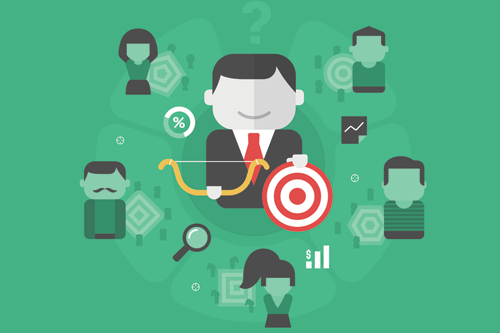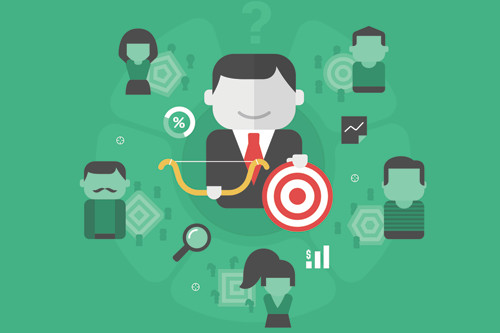By: Mandi Andrejka and Tanya Hyatt
Every one of us has, at some point, been part of a massive email chain of information that was irrelevant to us. Makes you want to bang your head on your desk, right? And don’t get us started on “reply all” responses—and all the reply-all responses to those responses telling people not to reply all! It can be both tragically funny and frustrating at the same time.

The point is this: maybe the original sender should have used a little more email targeting and segmentation. If they had just taken a little more time and considering who their email was really meant for, they could have avoided the inner-office chain of annoyance that lasted for hours.
Sending marketing and sales emails works in a similar fashion, just with a few extra nuances thrown into the planning to really make sure we’re respectfully and purposefully reaching our target end-user to avoid those head-meets-desk moments.
Let’s start with the basics, and then narrow our targeting into more specifics.
- Your subscribers are your friends…
One question we always ask while brainstorming any email campaign is, “Would I be okay with sending this email to my friends?” And we’re not just talking about the email content. We’re talking about timing, frequency, tone, and personalization.
If you’re left with any sense of doubt, then spot what you’re doing and evaluate why you’re feeling a little unsure. After all, you should treat your subscribers like friends. You want them to feel appreciated and respected, and you want to provide them with a good experience when receiving notifications from you and your company. They gave you their email address with a sense of trust that you would provide them value, so don’t let them down!
- …so feel free to get personal.
You don’t need to get as personal as you do with your friends, but you should at least know who your audience is before you start emailing them. Start at the highest level with the simplest information you have. For example, are they current customers or prospects?
Not only will the email itself change with this answer, but the delivery and frequency may alter as well. You will start to segment out your audience based on where they are in your sales cycle and marketing funnel.
Another simple question is, “Do you know their names and/or titles?”
You can leverage the power of psychology when you specifically call out a person’s name. It really does affect different regions of the brain. When you start your email off with “Dear ____,” you are essentially making what you are about to tell the email opener very personal. Your end-user will feel like you’re speaking to them directly and, therefore, be hooked from the start. Plus, it’s just common courtesy. You’re breaking down the barriers and perceptions that this is simply another email blast. You can further personalize your message using multiple forms of segmentation.
- Segmentation is an ongoing process.
One of the first ways to segment your list is by demographics. The email you send to superintendents shouldn’t be the same as the one that you send to teachers. While your product may benefit everyone in a district, the messaging and positioning should be relevant to the end-user specifically. This affects both the content and the tone of the email. Think about the challenges that each end-user may face and focus your message on how your solution can help solve that challenge.
Another powerful form of segmentation is geotargeting. Where your educators live can play a huge role in content, messaging, and delivery time. For example, your email itself may be pertinent to a specific state or region. If your Georgia customers start their school year several weeks before your Minnesota customers do, you want to keep that in mind so you’re sending them relevant back-to-school content when the time is right for them.
You’ll also want to be cognizant of time zones in which you start sending emails. This will be even more important if you have international customers. For example, if you are hosting a 24-hour flash discount and you set up emails to go out to UK customers at the same time as California customers, you will give some customers an unfair time advantage—or risk have others miss the message altogether.

Another rule of thumb is to avoid mass-sending emails to everyone in hopes that someone will “bite.” This fishing (not to be confused with phishing) technique will more than likely backfire and get you more unsubscribes than buy-ins. A 12th-grade science teacher really doesn’t care about 2nd-grade writing techniques. Make sure that the educator feels like you’re listening to them. Go beyond sharing what excites you to what you think will excite them!
Speaking of which, it pays to continuously check the engagement level of subscribers. If someone is routinely not opening your emails, why would you keep emailing them? Before completely writing them off, however, reevaluate whether or not your emails are pertinent to them. Are they on the wrong segmentation lists? Are they receiving emails that aren’t relevant to them? What about your subject lines? Make sure to evaluate all variables here before taking them off your lists.
Another aspect of segmentation is recognizing where your customers are in the sales cycle. Make sure that your emails contain relevant content that helps to nurture prospect leads to buying customers. For example, if you’ve just received an opt-in from a potential customer, then you’ll want to show them the value your company and solution offer first before jumping into push any kind of sales pitch. Guide them to blog articles, videos, white papers, and media coverage. If applicable, offer them a limited time free trial of something you offer (such as a course). This is the stage to demonstrate the value of your offerings—but don’t get salesy! That’s for a later stage in the buyer’s journey.
- Frequency can influence both unsubscribes and subscribes to your list.
Once you’ve crafted the perfect email or email, it’s tempting to just keep sending it until someone responds. In truth, there’s no easy answer to the question of how frequently you should send emails. We could spend a lot of time unpacking various factors, but this is a blog, not a novel. So, instead, let’s call out a couple items that you can take away now.
One of the best ways to avoid unsubscribes is to know your audience. Every business is different, and therefore, each business’s customers will be different. You will need to run your own email campaigns and analyze the data.
Also, don’t necessarily look to other industries when it comes to frequency. Where a fashion industry email campaign strategy may call for sending an email every day, that sort of activity would burn out an education list pretty quickly. Typically, education emails that are part of a campaign are sent 7–14 days apart, but emails that are meant to inform or promote may have different cadences.
No matter what you’re sending or when you’re sending it, stay aware of the big picture. Are you sending emails for a promotional campaign on top of webinar invites, individual sales team emails, and blog notifications? What you thought of as your four-part, one-month email campaign just turned into 7 emails a week. Don’t be the one who sends that “reply all” message—be the one whose messages all get replies!
Thanks for sharing!


